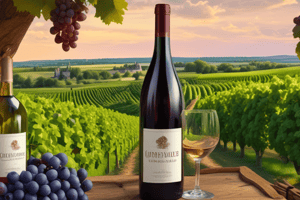Podcast
Questions and Answers
What is viticulture?
What is viticulture?
- The production of wine
- The process of pruning grapevines
- The cultivation and harvesting of grapes (correct)
- The science of horticulture
Which continent does not have grapes?
Which continent does not have grapes?
- South America
- Antarctica (correct)
- North America
- Africa
What are the duties of a viticulturist?
What are the duties of a viticulturist?
- None of the above
- Making wine, selling grapes, designing vineyards, and marketing
- Harvesting and packaging grapes, monitoring soil quality, and selling grapes
- Monitoring and controlling pests and diseases, irrigation, fruit development and characteristics, pruning, and deciding when to harvest (correct)
When was the earliest evidence of grape vine cultivation and winemaking discovered?
When was the earliest evidence of grape vine cultivation and winemaking discovered?
What is terroir?
What is terroir?
What is green harvesting?
What is green harvesting?
What is a field blend?
What is a field blend?
What is the preferred terrain for grape cultivation?
What is the preferred terrain for grape cultivation?
What are some hazards that can have an adverse effect on the wine produced from the grape or kill the vine itself?
What are some hazards that can have an adverse effect on the wine produced from the grape or kill the vine itself?
Flashcards are hidden until you start studying
Study Notes
Cultivation and Harvesting of Grapes
- Viticulture is the cultivation and harvesting of grapes, and is a branch of the science of horticulture.
- Grapes have high adaptability and can be found on every continent except Antarctica.
- The duties of a viticulturist include monitoring and controlling pests and diseases, irrigation, fruit development and characteristics, pruning, and deciding when to harvest.
- The earliest evidence of grape vine cultivation and winemaking dates back 8,000 years and was discovered in Armenia.
- The history of viticulture is closely related to the history of wine, and grape domestication occurred in the Near East in the early Bronze Age.
- Catholic monks were prominent viticulturists in the Middle Ages, and the concept of pruning for quality over quantity emerged during this time.
- Climate, slope, and soil are the three most important factors in grape cultivation, often referred to as terroir.
- Grape clusters can vary in compactness, and each grape berry contains a pedicel which attaches to the rachis.
- The skin of the grape contains the majority of aromatic substances and tannin, which become important in winemaking.
- Grape vines need approximately 1300-1500 hours of sunshine during the growing season and around 690 millimeters of rainfall throughout the year in order to produce grapes suitable for winemaking.
- Hillsides and slopes are preferred over flatter terrain for grape cultivation, and quality soil with good drainage is essential.
- Hazards that can have an adverse effect on the wine produced from the grape or kill the vine itself include frost, mildew, and bad soil.Green Harvest and Field Blend in Viticulture
Green Harvest:
- Green harvesting is the practice of pruning grapevines during the growing season to reduce yield and improve grape quality.
- It is done by removing grape bunches from the vines before they fully ripen.
- The process helps in the development of more numerous and mature flavour compounds.
- In Europe, many appellations restrict the yield permitted from a given area, so there is even more incentive to perform green harvesting when presented with excess crop.
- The excess crop must be sold for a pittance and used for industrial alcohol production rather than wine.
- The practice of green harvesting has increased in recent times in vineyards found in California and areas where the grapes grow easily.
Field Blend:
- A field blend is a wine that is produced from two or more different grape varieties interplanted in the same vineyard.
- In the days before precise varietal identification, a vineyard might be planted by taking cuttings from another vineyard, meaning that one vine could be Zinfandel and the next Carignan.
- Ridge Vineyards owns the Lytton Springs vineyards in Sonoma County, which were planted from 1900 to 1905 in what Ridge calls "a traditional field blend of about seventy percent Zinfandel, twenty percent Petite Sirah, and ten percent Grenache and Carignan."
- Gemischter Satz (Mixed set) is a wine term in German equivalent to a field blend.
- Other traditional field blends include Alsace wine, notably edelzwicker and gentil blends, and Douro wine.
Reference:
- Goldammer, T. (2015). Grape Growers Handbook: A Guide To Viticulture for Wine Production. ISBN 978-0-9675212-7-5.
Studying That Suits You
Use AI to generate personalized quizzes and flashcards to suit your learning preferences.




